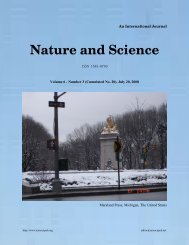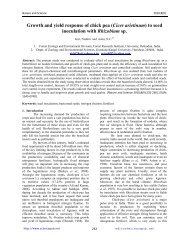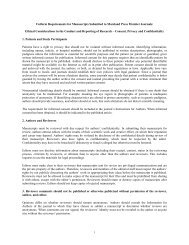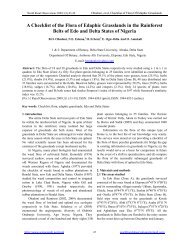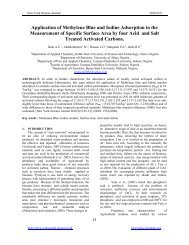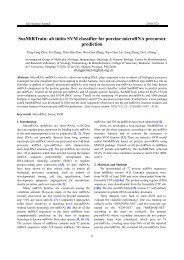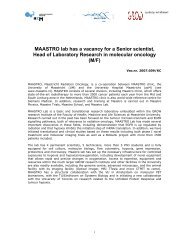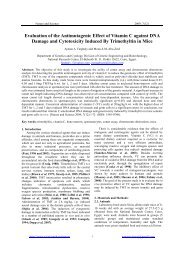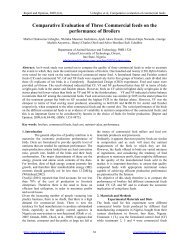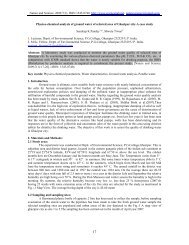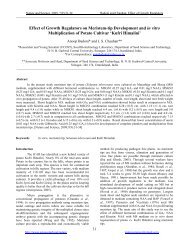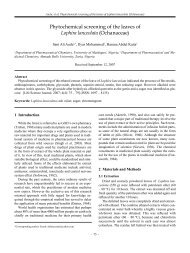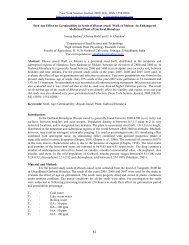Ecological, Social and Commercial Role of Lichens in India with ...
Ecological, Social and Commercial Role of Lichens in India with ...
Ecological, Social and Commercial Role of Lichens in India with ...
Create successful ePaper yourself
Turn your PDF publications into a flip-book with our unique Google optimized e-Paper software.
Acdemia Arena 2010, Supplement 0201<br />
http://www.sciencepub.net<br />
<strong>with</strong>out any consideration for susta<strong>in</strong>ability. The lichen collectors damage trees by chopp<strong>in</strong>g<br />
branches for collect<strong>in</strong>g lichens <strong>and</strong> firewood from trees for cook<strong>in</strong>g food while camp<strong>in</strong>g <strong>in</strong>/around<br />
forest sites. Poverty is so acute <strong>in</strong> some sections <strong>of</strong> the society that <strong>in</strong>comes <strong>of</strong> Rs.10, 000-35,000<br />
per annum are enough economic <strong>in</strong>centives for them.<br />
Depletion <strong>of</strong> lichen populations is a matter <strong>of</strong> concern from conservation st<strong>and</strong>po<strong>in</strong>t because<br />
<strong>of</strong> several reasons; be<strong>in</strong>g unique symbiotic organisms they contribute to biodiversity; they are<br />
ecologically important as food, shelter <strong>and</strong> nest<strong>in</strong>g material for a variety <strong>of</strong> wild animals <strong>and</strong> birds<br />
(Mc Cune <strong>and</strong> Geiser 1997). Among the animals which use lichens as food <strong>in</strong>clude the rare species,<br />
Himalayan musk deer, <strong>and</strong> others such as goats, sheep, pikas, mice <strong>and</strong> bats. Some birds use<br />
lichens as nest<strong>in</strong>g material (Banfield 1974, Conner 1983). Studies <strong>of</strong> the Northwest Pacific forests<br />
<strong>in</strong>dicate that lichens are important component <strong>of</strong> food cha<strong>in</strong>, <strong>and</strong> they play a significant role <strong>in</strong><br />
forest nutrient cycl<strong>in</strong>g (Pike 1978; Maser et al. 1985).<br />
In this article we describe the seasonal pattern <strong>of</strong> lichen fall from trees <strong>in</strong> a brown oak forest<br />
(Quercus semecarpifolia). No data are available on lichen fall <strong>in</strong> this part <strong>of</strong> world. We underst<strong>and</strong><br />
that collection <strong>of</strong> fallen lichens would reduce the depletion <strong>of</strong> lichen diversity <strong>and</strong> forest<br />
degradation. In order to collect lichens from the ground it is important to know the period <strong>of</strong> year<br />
when lichen falls are high. Quercus semecarpifolia is possibly; the most widely distributed species<br />
<strong>in</strong> high altitude areas (above 2400m) <strong>of</strong> the Himalaya, <strong>and</strong> is <strong>in</strong> a serious problem because <strong>of</strong> poor<br />
regeneration <strong>and</strong> ag<strong>in</strong>g population.<br />
MATERIALS AND METHODS<br />
One plot each <strong>of</strong> 0.22ha. (110m X20m) was identified both <strong>with</strong><strong>in</strong> open canopied st<strong>and</strong><br />
(located on a sun fac<strong>in</strong>g slope, hav<strong>in</strong>g lower moisture <strong>and</strong> tree diversity) <strong>and</strong> closed canopied st<strong>and</strong><br />
(slope hav<strong>in</strong>g more <strong>in</strong> moisture, more forest cover, <strong>and</strong> more tree diversity <strong>of</strong> Kharsu oak) between<br />
2750-2850m altitudes. 30 permanent plots <strong>of</strong> 1m² were placed <strong>with</strong><strong>in</strong> each the plot. The tree density<br />
<strong>in</strong> the area was estimated by plac<strong>in</strong>g 10, 10X10m² r<strong>and</strong>om quadrats (Saxena <strong>and</strong> S<strong>in</strong>gh, 1982).<br />
Canopy cover was estimated us<strong>in</strong>g a densiometer.<br />
The fallen lichen taxa from each permanent plot were collected at fortnightly <strong>in</strong>terval<br />
(represented on monthly basis). Fallen twigs on ground, bear<strong>in</strong>g lichens were collected carefully<br />
<strong>and</strong> were placed <strong>in</strong> poly bags for further identification. The lichens were scratched <strong>of</strong> the twigs<br />
71



